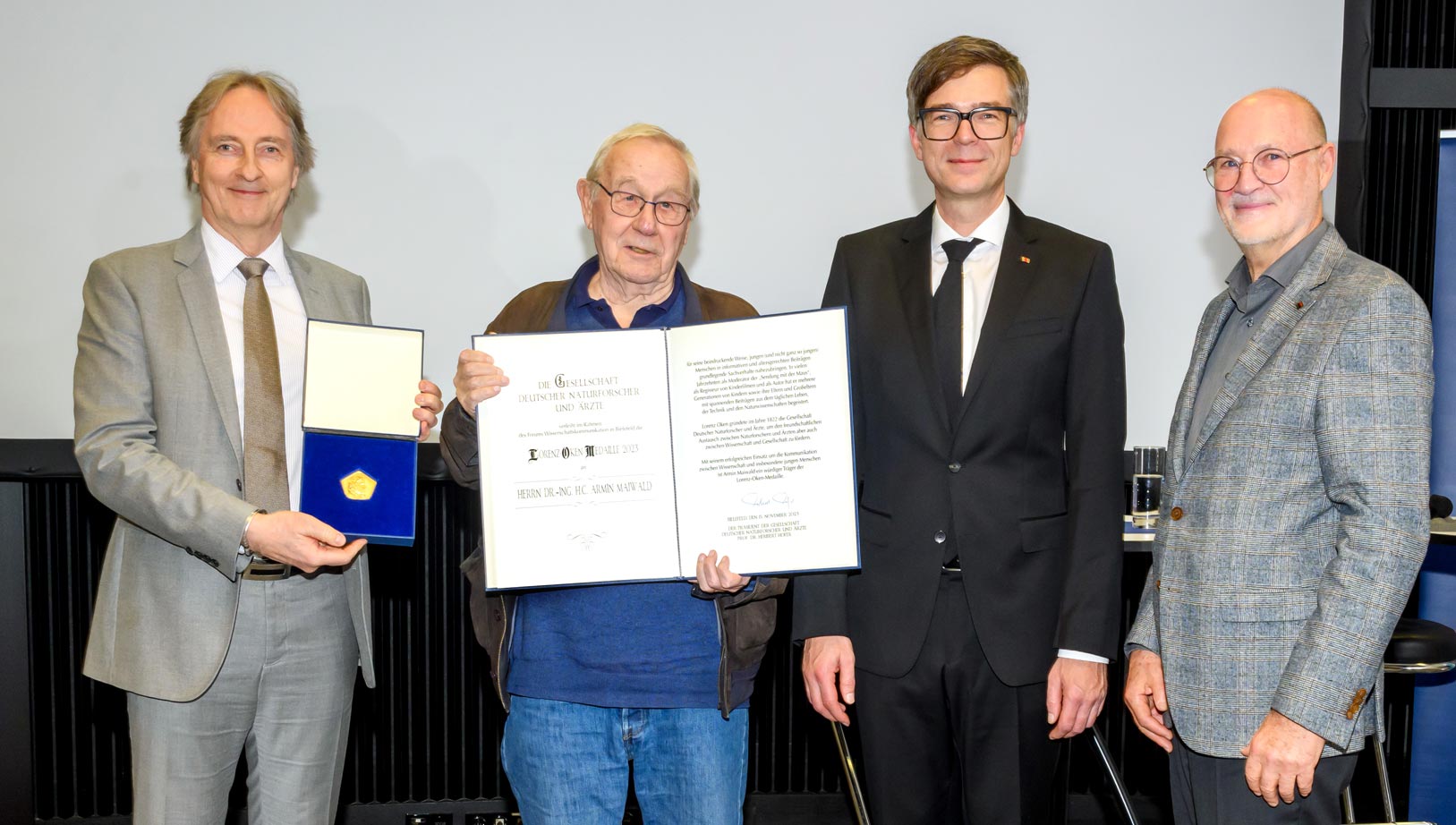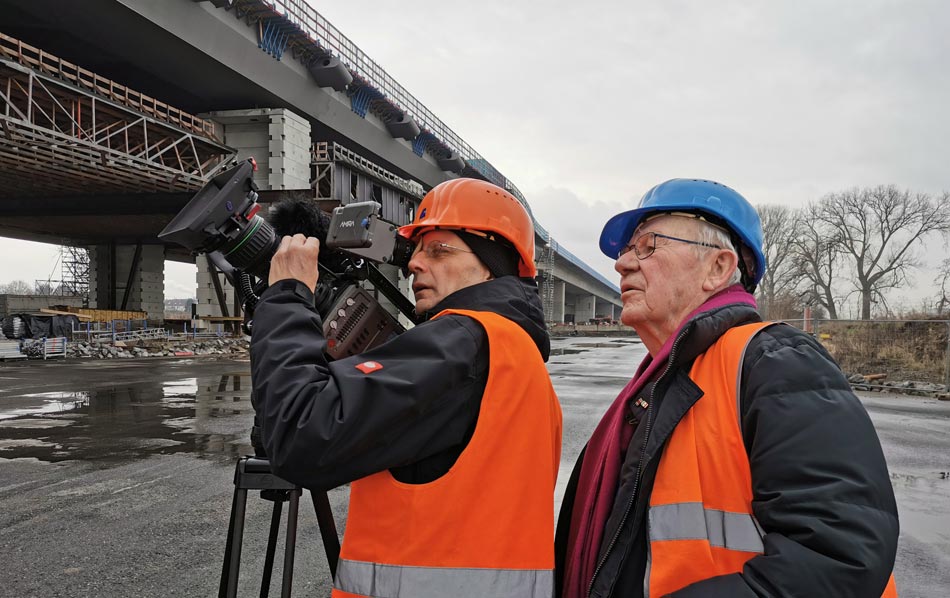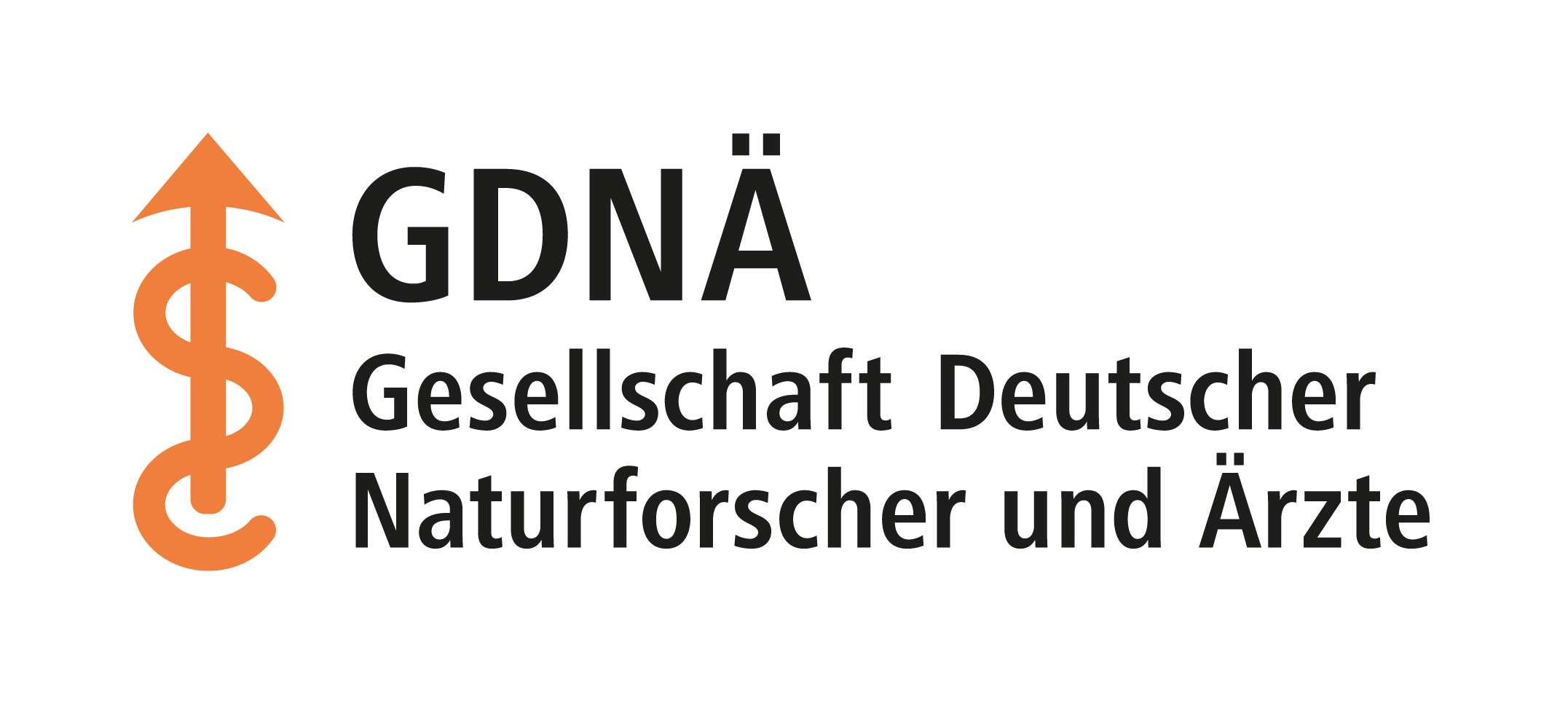AWARDED

© David Ausserhofer / Wissenschaft im Dialog
With medal and certificate in the Bielefeld Stadthalle (from left to right): GDNÄ President Professor Heribert Hofer, award winner Armin Maiwald, laudator Ralph Caspers and GDNÄ Secretary General Professor Michael Dröscher.
“Research until the doctor comes”
Armin Maiwald has been the face of Die Sendung mit der Maus for decades. For his exciting stories about science and technology, the GDNÄ awarded the presenter, author and director the Lorenz Oken Medal 2023. The award was presented on 15 November 2023 at the Science in Dialogue Forum in Bielefeld.
How do the pearls get into the shells? Why are there seasons? And why is milk white even though cows only eat green grass? Mr. Maiwald, you have been answering children’s questions in the “Sendung mit der Maus” for a good fifty years. Which question is asked most often?
Why is the sky blue – that’s the clear favourite. We have always made new programmes to answer the question in a contemporary way. The latest version is from 2018.
You and your team have already been awarded many prizes for the Sendung mit der Maus. Do you still have an overview?
There are now more than a hundred national and international prizes, which of course makes us very happy. A nice surprise last year was the honorary doctorate from RWTH Aachen University for special achievements in the education of children and young people.
Now you are receiving the Lorenz Oken Medal of the GDNÄ. What does the award mean to you?
I feel honoured and happy about the good company. Harald Lesch, Gert Scobel and Mai-Thi received the award before me. I am in good hands in this environment.
The Sendung mit der Maus has been running every Sunday morning for 52 years and has a large, loyal fan base. What makes it so successful?
We tell exciting stories about science. At the beginning we are as silly as everyone else and at least as curious. And then we take the viewers along on the journey. We go to Wesseling, for example, where we look for answers to a child’s question in the refinery: Why is oil so important?
How do you proceed in detail?
We work our way logically, step by step, and always comprehensibly. First the forest, then the individual tree, then the bark and finally the bark beetle. Instead of computer simulations, we rely on experiments with homemade models. If it’s about thermal deformation, for example, we explain it by cooking spaghetti, and what filtration is, we illustrate with a coffee filter. Foreign words are taboo for us, and we don’t do interviews. When it comes to a new topic, we research until the doctor comes. Maybe that’s even our greatest strength.

© FLASH Filmproduktion GmbH
Armin Maiwald with cameraman Kai von Westerman filming on the motorway bridge in Leverkusen.
How long do you work on a contribution?
That varies greatly. Some productions only take a few weeks, others take years. Our longest research was on the question of why vitamin C is so important for our bodies. It took us three years to get the hang of presenting that in a comprehensible way. Another long-term project is the construction of the new motorway bridge in Leverkusen. We have been accompanying the work since 2015 and have answered all kinds of questions about it in several broadcasts: How do the cables get to the bridge? How are the piers built? And how long does a bridge like this actually last? The seventh episode will be broadcast at the end of the year.
Are there also topics that you cut your teeth on?
Yes, there are. Quantum, for example. For years we have been trying everything possible to explain them in a way that is suitable for mice. But we keep coming up against the limits of representability and haven’t yet found the right trick. Another example is the conversion of plastic waste into petroleum. Children were already asking about this in the 1970s. We have visited an experimental plant in Switzerland and are still waiting for an announced plant in the Ruhr area. So we don’t have to grit our teeth completely, but we need a lot of patience.
There are now more than 2700 programmes with the mouse. How did it all begin?
In a pub in Cologne. At the end of the 1960s, I was sitting with a couple of WDR editors. We were discussing God and the world, and suddenly there was the idea for a new kind of children’s programme. One of us, Gert Kaspar Müntefering, then fought for it at Westdeutscher Rundfunk and won. In the beginning, the programme was made by a few people, but today a large team of reporters, presenters, illustrators and animators work for the Mouse. The whole thing is largely produced by the Cologne film company Flash, which I co-founded.
How has your programme changed over the years?
A lot has changed. It starts with the name. In 1968, when we started, the programme was still called Lach- und Sachgeschichten für Fernsehanfänger. In 1971 it was renamed Sendung mit der Maus. In the beginning, children came to the studio in Sunday clothes to be lectured. Soon we found it too stiff, too dry, too theoretical – a bit like school. But we definitely didn’t want to do school television. So we went out into life to look for answers to children’s questions. That’s how we still do it today.

© FLASH Filmproduktion GmbH
Sound engineer Christian Hennecke records the buzzing of bees in an apple orchard.
Are they really always children’s questions? And have the questions changed over time?
Yes, the starting point for our programmes are actually always children’s questions. It is not unusual for adults to be behind them, you can see that in the language and style. For some years now, the questions have become more technical. For example, they say: How does my mobile phone know that I’m standing on Cologne’s Cathedral Square? Or: What happens on the internet when I ask a question?
Children and young people are becoming less and less interested in the natural sciences, according to an often-heard complaint. Do you also see this trend?
Yes and no. I’m thinking of our satellite competition in which pupils from Bad Homburg took part. The team had spent six months building an observation satellite the size of a drinks can, but suddenly nothing worked when it was launched. But the students didn’t get discouraged and in no time at all they had a new CanSat, as the mini satellites are called. The replica actually took off. This is a great example of scientific enthusiasm. In school lessons, things often look different. Everyone is supposed to be involved, even the uninterested, and that can lower the level of the class quite a bit. The teachers are left alone with the problem, they can’t be blamed for that. I don’t see a perfect solution at the moment.
Today, research institutions of all kinds are trying to make their results as comprehensible as possible to the general public. Are they succeeding?
Only in part. I hear and read too many technical terms and far too much English. One talks about the CEO, the other about convenience products and both think that everyone knows what is meant. They are wrong, because to many people the terms mean absolutely nothing. Yet the public has a right to know – they should be able to understand what scientists are doing with taxpayers’ money.
What is the best way for researchers to reach the public?
Pictorial comparisons for technical terms are very effective. In our programme on vitamin C, for example, we talk about body police when we talk about macrophages. You can think about such comparisons in advance and test them in conversation with people who are not experts in the subject. If you have children at home, you can tell them what your work is about. If they then say, oh, that’s how it is, now I know what you do, you’re on the right track. The “aha” effect is important – for children, but also for adults.
Were you actually aware of the GDNÄ when you heard about the award?
No, I heard about the GDNÄ for the first time. Of course, I immediately did some research. My first impression was that the GDNÄ must be a pretty solid company. Two hundred years, you need good substance for that.
At 83, others have long since retired. You continue to work. What drives you?
Firstly, I haven’t learned anything else, and secondly, I still enjoy it. With every new story, the question arises: how can I tell it in an exciting and understandable way? Sometimes I have to really boil the grey cells in my brain to find good answers. It’s not always easy, but it keeps you fit.
Armin Maiwald was born in Cologne in 1940. He talks about his childhood in the multi-award-winning “Postwar Mouse”, a programme that was last broadcast in an updated version in 2020. Maiwald’s family was bombed out three times. After stations in Lower Silesia, Uffing am Staffelsee and Neuss, Maiwald returned to Cologne in 1953. There he studied theatre studies, German language and literature and philosophy and began working as an assistant director at WDR in Cologne in 1963. Armin Maiwald is one of the inventors of the programme mir der Maus -–together with Gert Kaspar Müntefering, Monika Paetow and the artist Isolde Schmitt-Menzel, who designed the Mouse logo. Maiwald has received the German Federal Cross of Merit and the Grimme Prize, among others, for his moderation and design of the programme. In 2023, the GDNÄ awarded him the Lorenz Oken Medal. Two schools in Monheim-Baumberg and in Radevormwald bear his name. Armin Maiwald has been married since 1965 and has two grown-up children.

© David Ausserhofer / Wissenschaft im Dialog
His television colleague Ralph Caspers, who has been part of the Maus team since 1999, gave the laudatory speech for the award winner to much applause.


© GDNÄ
Since 1984, the GDNÄ has been awarding its Lorenz Oken Medal to individuals who have rendered outstanding services to science communication. The award honours the founder of the GDNÄ, the natural scientist Lorenz Oken, who first convened a meeting of natural scientists and physicians in Leipzig in 1822. The photos show the front and back of the gold-plated medal for Armin Maiwald.
Science in dialogue
The Science Communication Forum is the largest conference for science communication in the German-speaking world. The conference is organised annually by Wissenschaft im Dialog (WiD), the joint organisation of German science for science communication. The Science Communication Forum 2023 will take place from 15 to 17 November in Bielefeld. The thematic focus is “Controversial, but fair – impulses for a new culture of debate”. The GDNÄ is a long-standing member of WiD and awards its Lorenz Oken Medal every two years at the forum conferences.

© FLASH Filmproduktion GmbH
Armin Maiwald during the filming of the story “Tyre production”. A cake with a tyre tread was baked as an explanation.
© David Ausserhofer / Wissenschaft im Dialog
Armin Maiwald with fans after the award ceremony.
© David Ausserhofer / Wissenschaft im Dialog
Armin Maiwald in an interview with Luise Laakmann and Thuy Anh Nguyen from “Wissenschaft im Dialog”.
